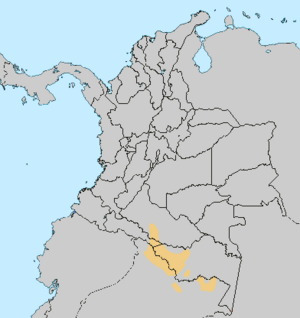| Bora–Witóto | |
|---|---|
| Witotoan | |
| (controversial) | |
| Geographic distribution | northwestern Amazon |
| Linguistic classification | Proposed language family |
| Subdivisions | |
| Glottolog | None |
 | |
Bora–Witóto (also Bora–Huitoto, Bora–Uitoto, or, ambiguously, Witotoan) is a proposal to unite the Boran and Witotoan language families of southwestern Colombia ( Amazonas Department) and neighboring regions of Peru and Brazil. Kaufman (1994) added the Andoque language.
Family division
Kaufman (1994) lists Bóran and Witótoan (Huitoto–Ocaina) as separate families (they are grouped together with Andoque as Bora–Witótoan; by 2007 he moved Andoque to Witotoan). (Note that Andoque was later demonstrated to be part of the Andoque–Urequena family.)
Genetic relations
Aschmann (1993) proposed Bora–Witoto as a connection between the Boran and Witotoan language families. Echeverri & Seifart (2016) refute the connection.
Kaufman (2007) includes Bora-Witoto in his Macro-Andean proposal, and added the Andoque language to the Witotoan family. [1] (Aschmann had considered Andoque a language isolate.) These proposals have not been accepted by other linguists. Gildea and Payne (2007) checked Bora-Witoto with Andoque, Proto-Cariban and Yagua, and found Bora-Witoto to be not related to any of the others.
Mason (1950: 236–238) groups Bora–Witoto, Tupian, and Zaparoan together as part of a proposed Macro-Tupí-Guaranían family. [2]
Vocabulary
Below is a comparison of selected basic vocabulary items in Proto-Bora-Muinane (i.e., Proto-Boran), Bora, Proto-Witotoan, Witoto, and Andoque.
gloss Proto-Bora-Muinane [3] Bora [4] Proto-Witotoan [5] Witoto [4] Andoque [4] head *niga-ɨ nīːkʷàɯ̀ ɨɸogɨ -tai hair *-hee- níːkʷākō ɨɸotɨraɨ ka-tai ʌka-be eye *aʤɨ-ɨ ācɯ̄ː uˑɨθɨ -ʔákʌ ear *nɨ()-meeʔu nɯ́mɨ̄̇ō ?**()po heɸo -bei nose *tɨhɨ-ʔu Tɨ́hɨ̄̇ò *topo-(ʔ) doɸo -pɤta tooth *iʔgai íʔkʷāhɨ̀ ?**iiʔ-gi-() iθido -kódi tongue *nehe nɨ́ːhɨ̄̇ʔkʷā ?**()pe iɨɸe -sodɤ̃ mouth *i-hɨ īʔhʲɯ̀ **(-)po(e) ɸue -ɸi hand *ʔutʦe ōhtsɨ̄̇ onoɟɨ -dobi foot *ttɨʔaai mēhtíā **(ï)ta() (lower leg) eˑɨɟɨ -dʌka breast *mɨppaino **xebae-gaï -ɲeé meat *ʔookuu, *duu éːkó ɟɨkɨθi -ɤ̃ta blood *tɨɨ **tï-xë(ʔe) dɨe -duʔs bone *bakkɨ p̻āhkɯ̄ iɟaikɨ -tadɤ̃ person *m()a-mɨnaa-ppi (sg.), *m()a-mɨnaa (pl.) kʷàhp̻ì ɨima ʝóʔhʌ name *momo **maime mamekɨ -ti dog *ʔuuʔi ōíp̻ʲē **xï̄ʔko hɨko ĩɲõ fish āmōmè ɟɨkɨaɨ bei louse *gaaini-ʔu kʷāánī ɨboma táʔsi tree *ɨmo-ʔo ɯ̄mèè ?**(aï)me() amena kɤ̃́ʔɤ̃dɤ leaf *-ʔaame ɨ́nāʔámɨ̄̇ rabe -sedɤ̃ flower θaɸia water *nɨ-ppai()u nēhp̻ākʲō **nō-() hɨnui dúʔu fire *kɨɨhɨ-gai kɯ́ːhɯ̄kʷā irai ʌʔpa stone néékʷājī **goti- noɸɨkɨ ɸisi earth *hiinɨ-he ìīɲɯ̀ *xáénï̄ʔ-xë enɨe ɲṍʔĩ salt *ɨmo **(ï)xaidzaï(ga) ɨaiθaɨ road **(na)xï̄() naˑɨθo dubɤ, õbɤ eat *matʧu **d(o)ʔ, **gōī(ne) guite -baʔi- die *gihe-βo baˑɨde ĩ-hʌ́ʌ- I *uu ōō **(k)ōō-xe(ʔe) kue o-ʔɤ you *ɨɨ **ō-xe(ʔe) o ha-ʔɤ
References
- ^ Kaufman, Terrence. 2007. South America. In: R. E. Asher and Christopher Moseley (eds.), Atlas of the World’s Languages (2nd edition), 59–94. London: Routledge.
- ^ Mason, J. Alden. 1950. The languages of South America. In: Julian Steward (ed.), Handbook of South American Indians, Volume 6, 157–317. ( Smithsonian Institution, Bureau of American Ethnology Bulletin 143.) Washington, D.C.: Government Printing Office.
- ^ Seifart, Frank, & Echeverri, Juan Alvaro (2015). Proto Bora-Muinane. LIAMES: Línguas Indígenas Americanas, 15(2), 279-311. doi: 10.20396/liames.v15i2.8642303
- ^ a b c González de Pérez, María Setlla (ed). 2000. Lenguas indígenas de Colombia: una visión descriptiva. Bogotá: Instituto Caro y Cuervo.
- ^ Aschmann, Richard P. (1993). Proto Witotoan. Publications in linguistics (No. 114). Arlington, TX: SIL & the University of Texas at Arlington.
Bibliography
- Aschmann, Richard P. (1993). Proto Witotoan. Publications in linguistics (No. 114). Arlington, TX: SIL & the University of Texas at Arlington.
- Campbell, Lyle. (1997). American Indian languages: The historical linguistics of Native America. New York: Oxford University Press. ISBN 0-19-509427-1.
- Echeverri, Juan Alvaro & Frank Seifart. (2016). Proto-Witotoan: A re-evaluation of the distant genealogical relationship between the Boran and Witotoan linguistic families.
- Gildea, Spike and Doris Payne. (2007). Is Greenberg's "Macro-Carib" viable? Bol. Mus. Para. Emílio Goeldi. Ciencias Humanas, Belém, v. 2, n. 2, p. 19-72, May-Aug. 2007 Online version: http://www.museu-goeldi.br/editora/bh/artigos/chv2n2_2007/Greenbergs(gildea).pdf
- Greenberg, Joseph H. (1987). Language in the Americas. Stanford: Stanford University Press.
- Kaufman, Terrence. (1990). Language history in South America: What we know and how to know more. In D. L. Payne (Ed.), Amazonian linguistics: Studies in lowland South American languages (pp. 13–67). Austin: University of Texas Press. ISBN 0-292-70414-3.
- Kaufman, Terrence. (1994). The native languages of South America. In C. Mosley & R. E. Asher (Eds.), Atlas of the world's languages (pp. 46–76). London: Routledge.
External links
- Proel: